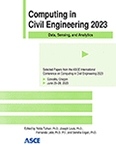Using Road Design Priors to Improve Large-Scale 3D Road Scene Segmentation
Publication: Computing in Civil Engineering 2023
ABSTRACT
Implementing geometric digital twins for roads can increase productivity and help streamline predictive maintenance. However, the related costs outweigh foreseen financial gain due to the manual work needed in scene recognition and modelling. The foremost step in automatically creating such digital twins is segmenting objects in 3D point clouds. Researchers have done extensive work to tackle this challenge, with deep learning solutions often preferable for solving multi-class problems. Yet, only several large-sized road objects get high-quality detection results. Other essential but rather smaller objects represent a further challenge. We utilise common properties of roads and road assets in a lightweight deep learning network training and data pre-processing to facilitate a broader range of highly detected objects. We show how these priors improve detection performance by a significant margin. Our work contributes to the improved automatic detection of most road object types, enabling automatic digitisation for roads and reducing related costs.
Get full access to this article
View all available purchase options and get full access to this chapter.
REFERENCES
Barazzetti, L., Previtali, M., and Scaioni, M. (2020). “Roads detection and parametrization in integrated bim-gis using lidar.” Infrastructures, 5(7), 55.
Behley, J., Garbade, M., Milioto, A., Quenzel, J., Behnke, S., Gall, J., and Stachniss, C. (2021). “Towards 3D LiDAR-based semantic scene understanding of 3D point cloud sequences: The SemanticKITTI Dataset.” The International Journal on Robotics Research, 40(8-9), 959–967.
Cordts, M., Omran, M., Ramos, S., Rehfeld, T., Enzweiler, M., Benenson, R., Franke, U., Roth, S., and Schiele, B. (2016). “The cityscapes dataset for semantic urban scene understanding.” Proceedings of the IEEE conference on computer vision and pattern recognition, 3213–3223.
Ester, M., Kriegel, H.-P., Sander, J., and Xu, X. (1996). “A density-based algorithm for discovering clusters in large spatial databases with noise.” kdd, Vol. 96, 226–231.
Fang, H., and Lafarge, F. (2019). “Pyramid scene parsing network in 3d: Improving semantic segmentation of point clouds with multi-scale contextual information.” Isprs journal of photogrammetry and remote sensing, 154, 246–258.
Goodfellow, I., Bengio, Y., and Courville, A. (2016). Deep Learning. MIT Press http://www.deeplearningbook.org.
Johnson, J. M., and Khoshgoftaar, T. M. (2019). “Survey on deep learning with class imbalance.” Journal of Big Data, 6(1), 1–54.
Liao, Y., Xie, J., and Geiger, A. (2021). “KITTI-360: A novel dataset and benchmarks for urban scene understanding in 2d and 3d.”.
Lin, T.-Y., Goyal, P., Girshick, R., He, K., and Dollár, P. (2017). “Focal loss for dense object detection.” Proceedings of the IEEE international conference on computer vision, 2980–2988.
Loshchilov, I., and Hutter, F. (2016). “Sgdr: Stochastic gradient descent with warm restarts.”.
Loshchilov, I., and Hutter, F. (2017). “Decoupled weight decay regularisation.”.
Poux, F., Mattes, C., Selman, Z., and Kobbelt, L. (2022). “Automatic region-growing system for the segmentation of large point clouds.” Automation in Construction, 138, 104250.
Qi, C. R., Yi, L., Su, H., and Guibas, L. J. (2017). “Pointnet++: Deep hierarchical feature learning on point sets in a metric space.” Advances in neural information processing systems, 30.
Qian, G., Li, Y., Peng, H., Mai, J., Hammoud, H., Elhoseiny, M., and Ghanem, B. (2022). “Pointnext: Revisiting pointnet++ with improved training and scaling strategies.” Advances in Neural Information Processing Systems, 35, 23192–23204.
Robert, D., Vallet, B., and Landrieu, L. (2022). “Learning multi-view aggregation in the wild for large-scale 3d semantic segmentation.” Proceedings of the IEEE/CVF Conference on Computer Vision and Pattern Recognition.
Sun, P., Zhao, X., Xu, Z., Wang, R., and Min, H. (2019). “A 3d lidar data-based dedicated road boundary detection algorithm for autonomous vehicles.” IEEE Access, 7, 29623–29638.
Xu, J., Zhang, R., Dou, J., Zhu, Y., Sun, J., and Pu, S. (2021). “Rpvnet: A deep and efficient range-point-voxel fusion network for lidar point cloud segmentation.” Proceedings of the IEEE/CVF International Conference on Computer Vision, 16024–16033.
Xu, S., Ye, P., Han, S., Sun, H., and Jia, Q. (2016). “Road lane modeling based on ransac algorithm and hyperbolic model.” 2016 3rd international conference on systems and informatics (ICSAI), IEEE, 97–101.
Yang, Q., Fan, S., Wang, L., and Wang, Y. (2016). “Road detection by ransac on randomly sampled patches with slanted plane prior.” 2016 IEEE 13th International Conference on Signal Processing (ICSP), IEEE, 929–933.
Yu, X., Rao, Y., Wang, Z., Liu, Z., Lu, J., and Zhou, J. (2021). “Pointr: Diverse point cloud completion with geometry-aware transformers.” Proceedings of the IEEE/CVF international conference on computer vision, 12498–12507.
Information & Authors
Information
Published In
History
Published online: Jan 25, 2024
ASCE Technical Topics:
- Architectural engineering
- Artificial intelligence and machine learning
- Automation and robotics
- Benefit cost ratios
- Building management
- Business management
- Computer programming
- Computing in civil engineering
- Design (by type)
- Engineering fundamentals
- Financial management
- Geometrics
- Highway and road design
- Highway and road management
- Highway transportation
- Highways and roads
- Hydraulic design
- Infrastructure
- Maintenance and operation
- Neural networks
- Practice and Profession
- Systems engineering
- Transportation engineering
Authors
Metrics & Citations
Metrics
Citations
Download citation
If you have the appropriate software installed, you can download article citation data to the citation manager of your choice. Simply select your manager software from the list below and click Download.
